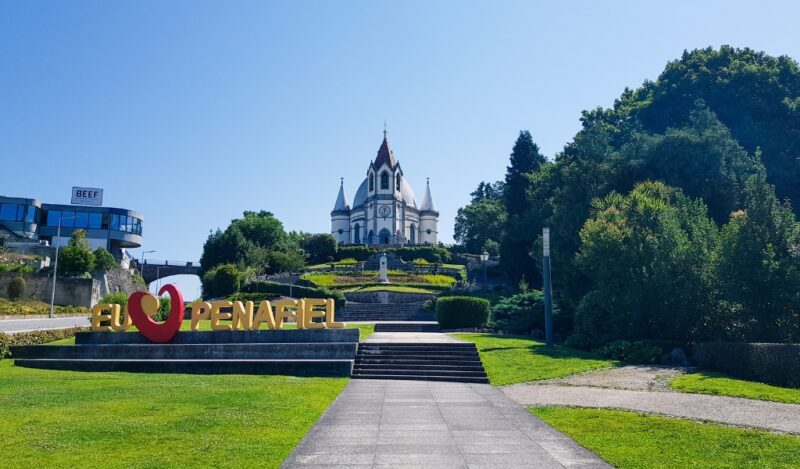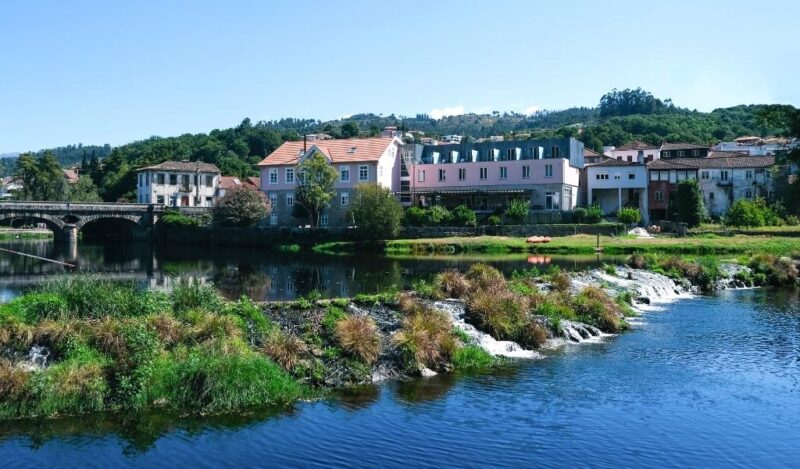Torres Vedras is a city and municipality in the Lisbon district, situated 50 km from the Portuguese capital. This means that this Torres Vedras itinerary is the ideal choice for a day trip from Lisbon or even the perfect stop on a road trip through the Oeste sub-region (in the Central Region)!
Torres Vedras has an impressive historical, artistic, and cultural past. And, in this Torres Vedras itinerary, you’ll have the opportunity to prove it in monuments such as the Castle of Torres Vedras, the Interpretation Center of the Jewish Community of Torres Vedras, or Saint Peter’s Church!
So, do you want to know more about the 1 Day In Torres Vedras: The Perfect Torres Vedras Itinerary? Keep reading!
This post may contain affiliate links, meaning I earn a small commission if you make a purchase, at no additional cost to you. Please read my disclosure & privacy policy for more information.
No time to read now? Pin it for later!


Brief History of Torres Vedras
The region where Torres Vedras is located today was inhabited by communities of hunter-gatherers and farmers, dating back to prehistoric times. And like so many other territories that today make up Portugal, it also received the presence of the Romans, Visigoths, and Arabs.
The name Torres Vedras comes from the Latin “Turres Veteras” (“Old Towers”) and is an allusion to a primitive fortification, possibly erected in the Roman period. But when King Afonso Henriques conquered this region in 1147, Torres Vedras was under Muslim rule.
On August 15th, 1250, King Afonso III granted the Charter to the old town, at a time when it was already witnessing growth both in terms of population and economics. Part of this prosperity is due to the many religious communities that have settled here.

It’s also known that Torres Vedras was one of the lands of the “House of the Queens”, a set of territorial goods offered by Portuguese monarchs to their consorts as a marriage dowry. Among other towns and cities that were “Lands of Queens”, there are Óbidos, Sintra, Porto de Mós, Alenquer, Abrantes, and Torres Novas.
After receiving the New Charter from King Manuel I on June 1st, 1510, Torres Vedras only regained prominence in the early 19th century, in the context of the Peninsular War. Built between 1809 and 1812, the more than 150 defensive fortifications that make up the so-called Lines of Torres Vedras prevented the advance of Napoleon Bonaparte’s troops on the city of Lisbon!
Visiting Torres Vedras
In my opinion, the best way to visit the city of Torres Vedras is on a day trip from Lisbon. And to get there from the Portuguese capital, you have two options: travel by car (about 50 km) or by public transportation (45 minutes by bus).
However, Torres Vedras is also an excellent stop on a road trip through the Oeste sub-region and the Lisbon district! In that case, I suggest you explore other destinations in the vicinity: Sobral de Monte Agraço (16 km), Lourinhã (20 km), Mafra (25 km), Arruda dos Vinhos (25 km), Bombarral (27 km), Alenquer (30 km), Cadaval (30 km), Óbidos (40 km), or Peniche (40 km).
Torres Vedras Itinerary
Castle of Torres Vedras
This Torres Vedras itinerary starts at the Castle of Torres Vedras (in Portuguese, Castelo de Torres Vedras), the most important monument in the city. As its first occupants date from the beginning of the third millennium BC and the fortress was later reinforced by the Romans and Arabs, you can see traces from different times!

The Interpretation Center of the Castle of Torres Vedras is open from Tuesday to Sunday, from 10 am to 1 pm and from 2 pm to 6 pm (from September to May), or from 10 am to 1 pm and from 2 pm to 7 pm (from June to August). In addition to Mondays, the monument is closed on January 1st, Carnival Sunday and Tuesday, Easter Sunday, May 1st, December 24th and 25th. And entry is free!
Church of Santa Maria do Castelo
The next stop on this Torres Vedras itinerary is the Church of Santa Maria do Castelo (in Portuguese, Igreja de Santa Maria do Castelo), which was built in the second half of the 12th century, shortly after King Afonso Henriques took over the Moorish castle. And since its entrance porticos are one of the few examples of Romanesque architecture in the municipality, they were classified as a National Monument in 1910.


And did you know that the Church of Santa Maria do Castelo has a second bell tower, adjacent to the first? In fact, this tower has functioned as a clock tower since the end of the 16th century – although it was destroyed by the Lisbon Earthquake of 1755 and was rebuilt between 1763 and 1764!
The Church of Santa Maria do Castelo is open from Tuesday to Sunday, from 10 am to 6 pm!
Interpretation Center of the Jewish Community of Torres Vedras
This Torres Vedras itinerary continues at the Interpretation Center of the Jewish Community of Torres Vedras (in Portuguese, Centro de Interpretação da Comunidade Judaica de Torres Vedras), located a few steps from the Old Jewish Quarter. Inaugurated on May 18th, 2017, this museum space intends to value the Jewish heritage of Torres Vedras, at a historical, cultural, and social level.

The Interpretation Center of the Jewish Community of Torres Vedras is open from Tuesday to Sunday, from 10 am to 1 pm and from 2 pm to 6 pm (from September to May), or from 10 am to 1 pm and from 2 pm to 7 pm (from June to August). In addition to Mondays, the monument is closed on January 1st, Carnival Sunday and Tuesday, Easter Sunday, May 1st, December 24th and 25th.
City Hall & Fountain
The next stop on this Torres Vedras itinerary is the Torres Vedras City Hall building (in Portuguese, Câmara Municipal or Paços do Concelho). First mentioned in 1337, the City Hall building was built between 1752 and 1776 – after the original was destroyed in a fire.


As for the Fountain located right next to it, it was carved in 1775. In Pombaline style, it received the water that came from the Canos Fountain (in Portuguese, Chafariz dos Canos), the most famous fountain in the city. Still in the Municipality Square, you can admire a fragment of the Pillory of Torres Vedras.
Saint Peter’s Church
This Torres Vedras itinerary continues at Saint Peter’s Church (in Portuguese, Igreja de São Pedro), another religious temple that has been a National Monument since 1910. Its origins date back to the reign of King Afonso Henriques, even though it was rebuilt in the early 16th century and later, after the Lisbon Earthquake of 1755.

As you can see from the photograph, Saint Peter’s Church has a Manueline-style entrance portico on the main façade. And inside, it’s worth mentioning the gilded high altar (from the late 17th century) and the tile panels lining the walls (from the 16th and 17th centuries).
Saint Peter’s Church is open from Tuesday to Sunday, from 10 am to 6 pm!
“Raízes do Amanhã”, by Jota Aracê
The next stop on this Torres Vedras itinerary is the urban artwork “Raízes do Amanhã” (or “Roots of Tomorrow”, in English), by Jota Aracê. A Brazilian plastic artist, João Paulo Malara Capparelli has been dedicating himself full-time to graffiti since 2013. Since then, he has spread his art on city walls all over the world.

Painted in May 2016, the mural “Roots of Tomorrow” depicts a boy surrounded by great classics of Portuguese and foreign literature, such as “Oliver Twist” (Charles Dickens), “Mensagem” (Fernando Pessoa), “Viagens na Minha Terra” (Almeida Garrett), “A Menina do Mar” (Sophia de Mello Breyner Andressen), or “Ensaio Sobre a Cegueira” (José Saramago).
“Scratching the Surface”, by Vhils
This Torres Vedras itinerary continues with the urban artwork “Scratching the Surface”, by Vhils. A Portuguese plastic artist, Alexandre Farto began to gain international recognition in the late 2000s, when he developed a technique for creating human portraits with explosives.

“Scratching the Surface” is a series started in 2007, which illustrates well this new way of making urban art, using the city itself as raw material. The work that beautifies the Santiago Car Park, together with “Roots of Tomorrow”, was produced in March 2009.
Church of Our Lady of Mercy
The last stop on this Torres Vedras itinerary is the Church of Our Lady of Mercy (in Portuguese, Igreja de Nossa Senhora da Misericórdia), the most imposing and sumptuous religious temple in the city. Construction work began in 1681 and lasted almost three decades, with the project being completed in 1710.

Since the Church of Our Lady of Mercy belonged to a series of buildings of the Santa Casa da Misericórdia, it’s possible to see a small balcony over the access door to the High Choir, which allowed the patients of the Misericórdia Hospital to attend the liturgical ceremonies.
The Church of Our Lady of Mercy is open from Tuesday to Sunday, from 10 am to 6 pm!
Other Places in Torres Vedras
Santa Cruz Beach
If you like the beach, then you have to add Santa Cruz Beach (in Portuguese, Praia de Santa Cruz) to your Torres Vedras itinerary! With a long sandy beach, clear waters, and a very photogenic boulder (the Penedo do Guincho), Santa Cruz Beach is the most popular seaside resort in this region.


Curiously, not all of this sand is called Santa Cruz Beach. Depending on the concessionaire, this stretch of sand is called (from south to north): Amoeiras Beach, Formosa Beach, Penedo do Guincho Beach, Santa Cruz Beach, Santa Helena Beach, Norte Beach, Física Beach, Pisão Beach, Amoreira Beach, Mirante Beach, or Vigia Beach (or Tomorrow Beach)!
Blue Beach
Blue Beach (in Portuguese, Praia Azul) is another beach in Torres Vedras, a little further south of Santa Cruz Beach. And even though it also has large sand and blue waters (hence the name), it’s a beach sought after for its cliffs, dunes, and river. After all, this is where the Mouth of the Sizandro River is!

In my opinion, Blue Beach is more recommended for families or people looking for peace on the beach – something that is much harder to find in Santa Cruz Beach. Access is very easy and there’s a large sand car park at the entrance to the walkway.
Map of the Torres Vedras Itinerary
Share this blog post on your social media!
More Posts about Portugal
4 Best Monasteries In Portugal (That You Should Visit This Year)
5 Best Palaces In Sintra (That You Should Visit This Year)
1 Day In Penafiel: The Perfect Penafiel Itinerary
More Posts about Travel Itineraries
1 Day In Penafiel: The Perfect Penafiel Itinerary
2 Days In Arcos De Valdevez: The Perfect Arcos De Valdevez Itinerary
1 Day In Alcobaça: The Perfect Alcobaça Itinerary
What Photography Gear Do I Use?
- Camera Body: Fujifilm X-T4 Mirrorless
- Camera Lens: Fujinon XF 18-55 mm F2.8-4 R LM OIS
- Tripod: Manfrotto Compact Action
- Small Tripod: Manfrotto PIXI Mini
- Smartphone Adaptor: Manfrotto PIXI Clamp
- Memory Card: SanDisk 128GB Extreme PRO SDXC





